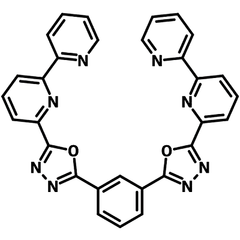BPy-OXD
CAS Number 866117-19-3
High Purity Sublimed Materials, Materials, Semiconducting Molecules, TADF Materials
BPy-OXD, excellent ETL and HBL material
Used with electron donating materials to create highly efficient OLED devices
BPy-OXD (CAS number 866117-19-3), namely 1,3-Bis[2-(2,2'-bipyridine-6-yl)-1,3,4-oxadiazo-5-yl]benzene, is a bipyridyl-substituted oxadiazole derivative with a symmetrical chemical structure of two bipyridyl oxadiazole units being attached on a benzene ring at meta-positions.
Due to the electron deficient nature of both bipyridine and oxadiazole, BPy-OXD has excellent electron accepting, electron transporting, and hole blocking abilities. It also exhibits electrical operation durability with a high glass transition temperature (Tg = 106 ℃). The electron mobility in the vacuum-deposited films of Bpy-OXD is 30 times higher than that of OXD-7.
Compared to OXD-7, which has bulky tert-butyl terminals, BPy-OXD is completely planar due to the intramolecular H---N hydrogen bonding. This leads to significantly large anisotropy of molecular orientation in the film.
BPy-OXD can also be used with electron donating materials, i.e. m-MTDATA, to form exciplexes as active emitting layer materials for highly efficient OLED devices.
General Information
| CAS number | 866117-19-3 |
|---|---|
| Full name | 1,3-Bis[2-(2,2'-bipyridine-6-yl)-1,3,4-oxadiazo-5-yl]benzene |
| Chemical formula | C30H18N8O2 |
| Molecular weight | 522.52 g/mol |
| Absorption | λmax 276 nm, 308 nm (in THF) |
| Phosphorescene | λmax 348 nm (in THF) |
| HOMO/LUMO | HOMO = 6.60 eV, LUMO = 2.90 eV [1] |
| Synonyms | Bpy-OXDm |
| Classification / Family | Oxadiazole derivatives, Electron transport layer, Hole blocking layer, Phosphorescent host materials, Light-emitting diodes, Organic electronics, , Sublimed materials. |
Product Details
| Purity | Sublimed >99.0% (HPLC) |
|---|---|
| Melting point | Tg = 106 ℃ |
| Appearance | White powder/crystals |
*Sublimation is a technique used to obtain ultra pure-grade chemicals. For more details about sublimation, please refer to the Sublimed Materials.
Chemical Structure

Device Structure(s)
| Device structure | ITO/2-TNATA (10 nm)/NPB (30 nm)/TCTA (10 nm)/CBP:6 wt% Ir(ppy)3 (30 nm)/BCP (10 nm)/Bpy-OXD (30 nm)/LiF/Al [2] |
|---|---|
| Colour |
|
| Max. Current Efficiency | 35.42 cd/A |
| Max. EQE | 10.16% |
| Device structure | ITO/2-TNATA (10 nm)/NPB (30 nm)/TCTA (10 nm)/CBP:6 wt% Ir(ppy)3 (30 nm)/Bphen (10 nm)/Bpy-OXD (30 nm)/LiF/Al [2] |
|---|---|
| Colour |
|
| Max. Current Efficiency | 43.18 cd/A |
| Max. EQE | 12.10% |
| Device structure | ITO/2-TNATA (10 nm)/NPB (30 nm)/TCTA : 10 nm)/CBP : 6 wt% Ir(ppy)3 (20 nm)/Bpy-OXD:6 wt% Ir(ppy)3 (10 nm)/Bphen(10 nm)/Bpy-OXD (30 nm)/LiF/Al [3] |
|---|---|
| Colour |
|
| Max. Current Efficiency | 56.75 cd/A |
| Max. EQE | 15.49% |
*For chemical structure information, please refer to the cited references.
Pricing
| Grade | Order Code | Quantity | Price |
|---|---|---|---|
| Sublimed (>99.0% purity) | M2339A1 | 100 mg | £220 |
| Sublimed (>99.0% purity) | M2339A1 | 250 mg | £440 |
| Sublimed (>99.0% purity) | M2339A1 | 500 mg | £740 |
| Sublimed (>99.0% purity) | M2339A1 | 1 g | £1250 |
MSDS Documentation
 BPy-OXD MSDS Sheet
BPy-OXD MSDS Sheet
Literature and Reviews
- Bipyridyl oxadiazoles as efficient and durable electron-transporting and hole-blocking molecular materials, M. Ichikawa et al., J. Mater. Chem., 16, 221-225 (2006); DOI: 10.1039/B510720B.
- Enhanced electroluminescence and reduced efficiency roll-off in electrophosphorescent devices using a very high electron mobility material as emitter host and electron transporter, T. Li et al., J. Phys. D: Appl. Phys. 42, 065103 (2009); DOI: 10.1088/0022-3727/42/6/065103.
- Reduced efficiency roll-off in phosphorescent organic light emitting diodes at ultrahigh current densities by suppression of triplet-polaron quenching, F. Zang et al., Appl. Phys. Lett. 93, 023309 (2008); DOI: 10.1063/1.2955527.
